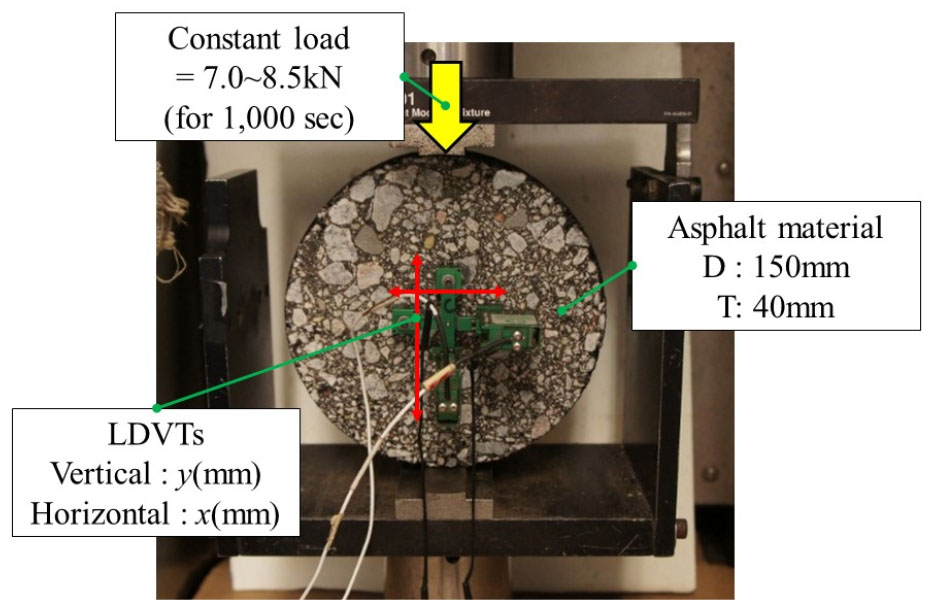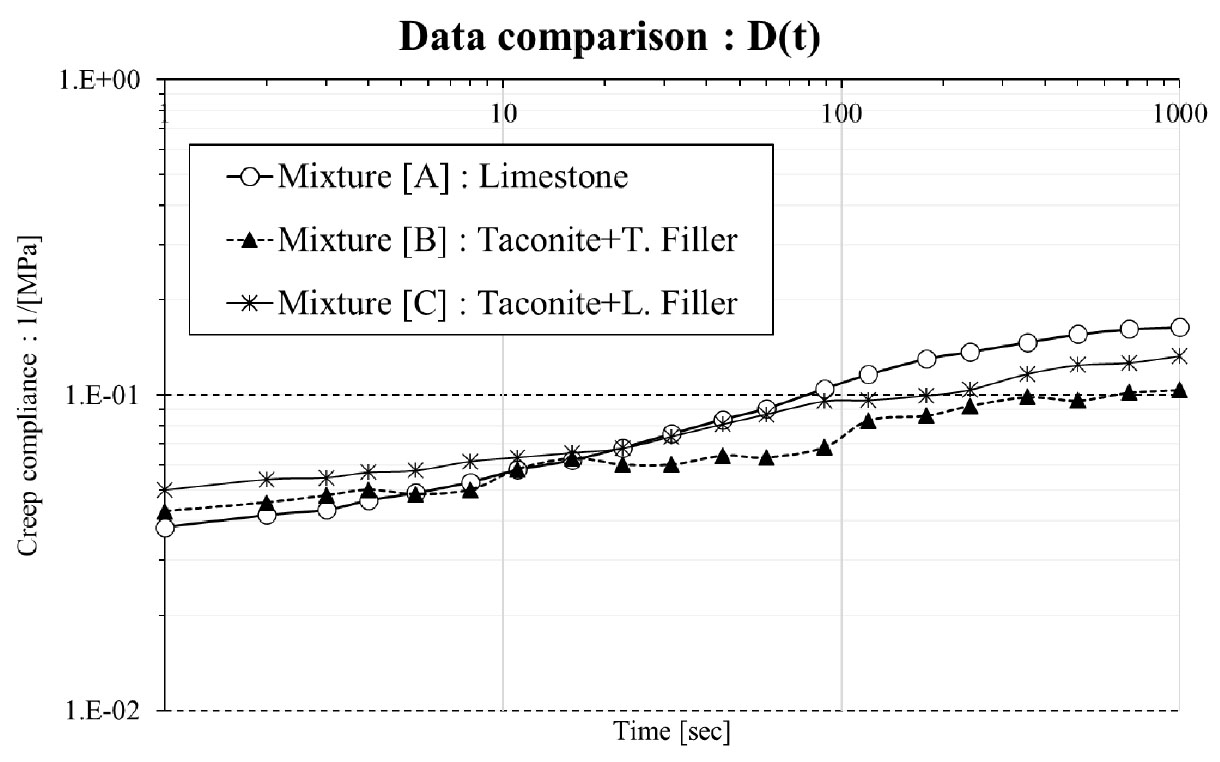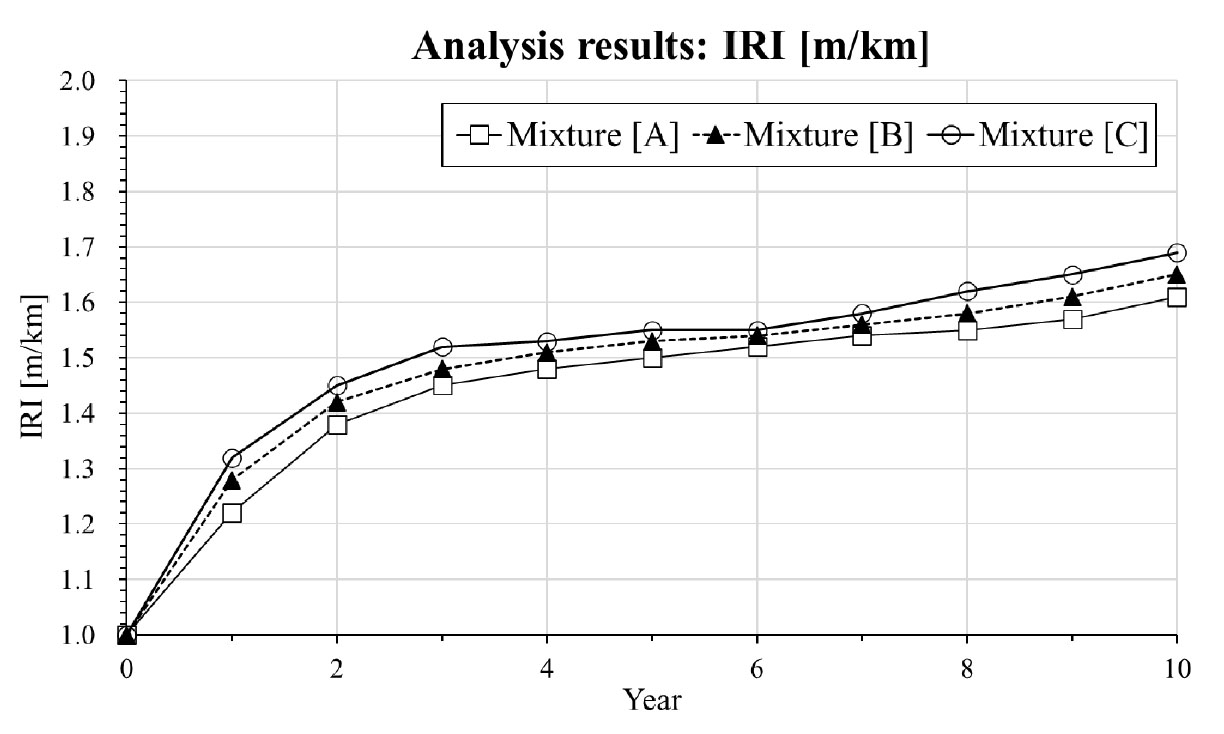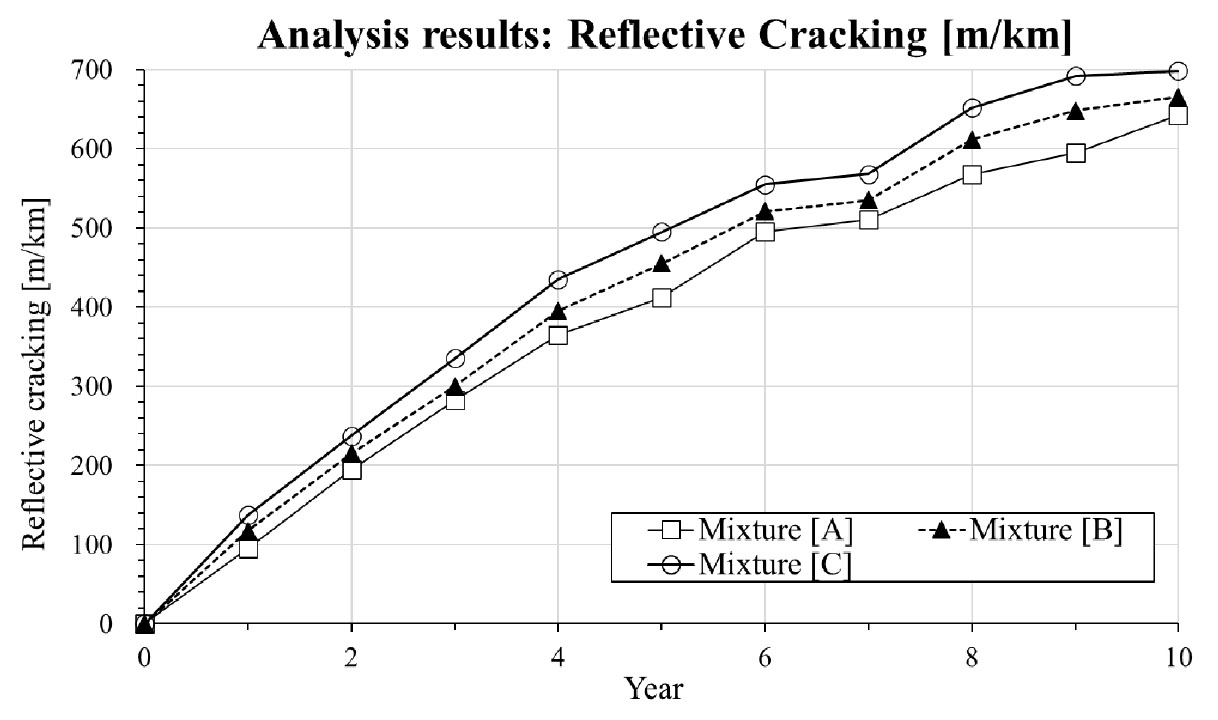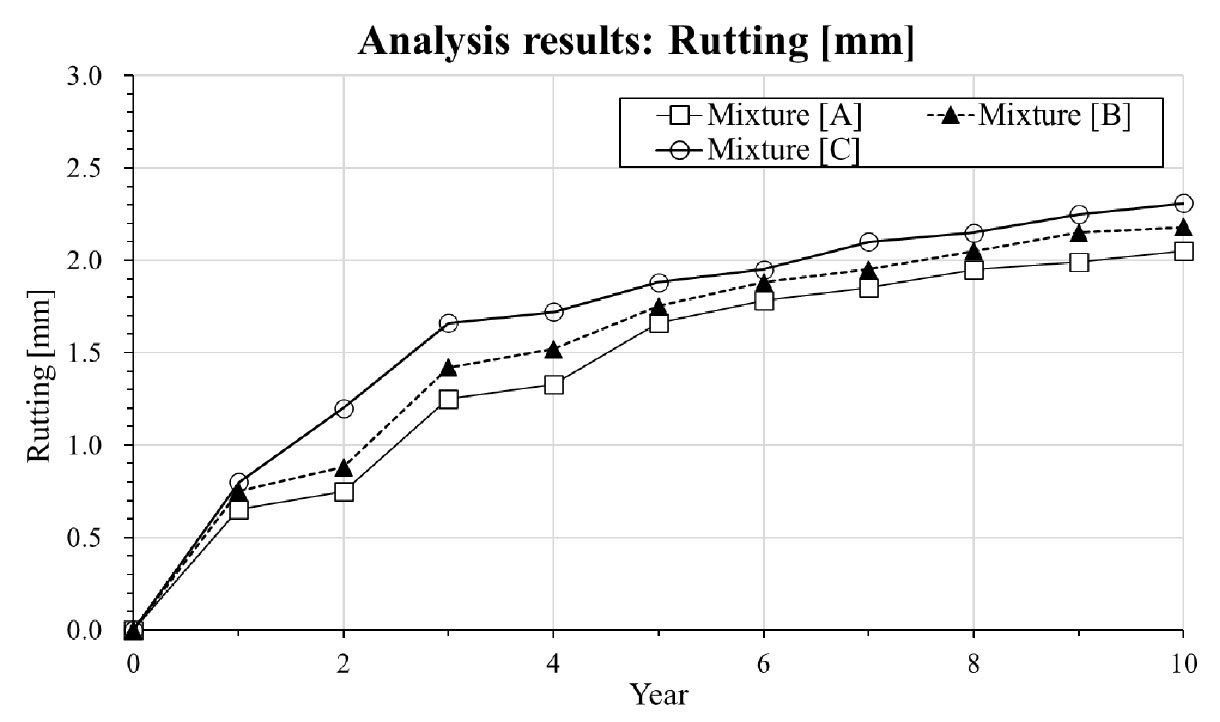1. Introduction
2. Experimental work: material preparation
3. Experimental work: IDT creep test
4. Pavement design analysis and simulation
5. Summary and conclusion
1. Introduction
Asphalt material is a composite material consisted of three elements: aggregate, asphalt binder and air-void (Moon, 2012; Cannone Falchetto et al., 2021). Each element takes a different mechanical role. Asphalt binder holds the aggregate together which provides physical bonding effect and flexibility in asphalt mixture. Aggregate provides the role of load bearing capacity in asphalt mixture by means of interlocking system which makes asphalt pavement durable (Moon, 2012). Therefore, selecting reasonable and proper aggregate source significantly affect mechanical performance of asphalt pavement (Moon, 2012). Along with performance issue, saving current construction budget and mitigating environmental pollution issue are other challenges in asphalt pavement industry (Moon et al., 2014; Saed et al., 2022; Xu et al., 2022). Many efforts were performed in pavement agencies to find out alternative (and/or recyclable) aggregate source in U.S. for past decades. Many candidates such as Reclaimed Asphalt Pavement (RAP), roofing shingles and taconite were considered as alternative aggregate source in asphalt industry (Moon et al., 2014; Cannone Falchetto et al., 2021). In this paper, feasibility of taconite aggregate: sort of iron ore which widely produced in northern Minnesota territory in U.S. (Zanko et al., 2003), in actual asphalt pavement construction is considered. The taconite aggregate: a byproduct of taconite mining industries, is consisted of quartz (55~60%), magnetite (10~12%), iron oxides and silicates (Zanko et al., 2003). Generally, taconite aggregate presents higher amount of compressive strength (e.g. 193~621 MPa) and absorption (e.g. 1.2%) than the conventional granite aggregate (i.e. compressive strength : 55~179 MPa, absorption : 0.74%) (Plummer, 1976; Stump and Hetzer, 1999; Zanko, 2003). Table 1 shows the major chemical composition of taconite aggregate. Many researches studied the feasibility of taconite application on asphalt pavement (Oreskovich and Patelke, 2006). As a result, reasonable (and/or acceptable) level of pavement performance was observed when taconite aggregate is used as alternative aggregate source compared to the conventional aggregate source (i.e. limestone or granite) application. However, most of studies were limited into evaluate taconite aggregate performance by means of simple experimental works which can not be appropriate for evaluating actual asphalt pavement performance. Even no previous studies considered actual pavement performance simulation works in case of taconite aggregate application. In this paper, feasibility of taconite aggregate application was evaluated by means of mechanical testing results (AASHTO, 2003) and pavement design tool named AASHTOWare-Pavement ME (Mechanical-Empirical) program (i.e. MEPDG, AASHTO, 2022). Fig. 1 presents the schematic research process performed in this paper.
Table 1.
Chemical composition of taconite aggregate
2. Experimental work: material preparation
All the taconite aggregates were provided by United Taconite American Corporation (UTAC) Thunderbird mine in Eleventh located in northern Minnesota (e.g. Cuyuna range, Mesabi range and Vermillion range). Based on the specification detailed in Minnesota Department of Transportation (MN/DOT, Zanko, 2009) all the asphalt mixtures were prepared with Superpave Gyratory Compactor (SGC) in University of Minnesota pavement research group. Three types of different asphalt mixture (i.e. Mixture [A], [B], [C]) were considered to evaluate performance of taconite aggregate extensively. The brief information about prepared asphalt mixtures is shown in Table 2. Note that PG 64-22 asphalt binder: a regular asphalt binder used for county road and highway network construction, (AASHTO, 2010) was used in this research.
Table 2.
Prepared asphalt mixtures
3. Experimental work: IDT creep test
Generally, low temperature cracking is a crucial factor for asphalt material when alternative (and/or recyclable) aggregate source is used due to increase of brittle characteristics (Moon et al., 2014; Cannone Falchetto et al., 2021; Saed et al., 2022; Xu et al., 2022). This brittleness of asphalt material is directly correlated into cracking distress in actual pavement. The numerical intensity level of brittleness in asphalt material can be computed, estimated and analyzed by low temperature creep test approach. Due to this reason low temperature creep test: Indirect Tensile (IDT) test (AASHTO, 2003), was considered in this paper. Brief information about IDT test is shown in Fig. 2 and Table 3, respectively.
Table 3.
Schematic information of IDT creep testing
In IDT test (AASHTO, 2003), creep compliance: D(t), can be computed based on the following equation (see Equations (1), (2), (3)).
Where,
D(t) = creep compliance (1/MPa),
S(t) = creep stiffness (MPa),
H(t)m = measured horizontal deflection at time t (mm),
D = diameter of test specimen (=150 mm),
T = thickness of test specimen (=40 mm),
GL = gauge length (=38 mm),
P = applied load (7.0~8.5 kN, constantly),
In asphalt material higher value of creep stiffness: S(t), provides negative performance at low temperature cracking resistance ability due to increase of brittleness (Moon, 2010; Moon, 2012; Moon et al., 2014; Cannone Falchetto et al., 2021). From Equation (1), creep compliance: D(t), is the reverse value of creep stiffness: S(t), higher value of D(t) provides better performance against low temperature cracking distress in asphalt material. In addition, D(t) value is used as “Level 1” input factor in AASHTOWare-Pavement ME design: a commercial pavement design and performance simulation software (i.e. MEPDG, AASHTO, 2022). The computed results of D(t) from Mixtures [A], [B], [C] are shown in Fig. 3 and Table 4.
Table 4.
D(t) result comparisons: Mixture [A], [B], [C] (temp –24°C, t = 1~1,000 sec)
The D(t) of limestone mixture (i.e. Mixture [A]) showed lower values than taconite mixtures (i.e. Mixtures [B] and [C]) from 0 to 16 seconds: at the beginning of test period. However, higher values of D(t) were observed in Mixture [A] compared to the other two mixtures (i.e. Mixtures [B] and [C]). This means relatively negative performance about low temperature cracking resistance can be expected for taconite aggregate added asphalt mixtures compared to the conventional asphalt mixture. However, Mixture [B]: taconite aggregate with limestone filler, presented almost identical (and/or reasonable) IDT D(t) values compared to the Mixture [A]. Based on the findings in Fig. 3 and Table 4, it can be said that taconite aggregate can successfully applied in asphalt pavement industry even though limited amount of testing was performed. However, the results in Fig. 3 and Table 4 are only laboratory experimental results which means extensive pavement structure analysis (and/or simulation) is needed to further verify findings in this paper. In this paper, addition taconite aggregate performance analysis using AASHTOWare-Pavement ME design (i.e. MEPDG, AASHTO, 2022) was performed. More detailed information is provided in the next section.
4. Pavement design analysis and simulation
A commercial pavement design program named: AASHTOWare-Pavement ME design (i.e. MEPDG, AASHTO, 2022) is applied to evaluate effect of taconite aggregate on pavement performance. In South Korea, pavement overlay construction: paving newly asphalt pavement on existing concrete pavement, is widely applied due to increase need of aged concrete pavement remodeling work (Kim et al., 2019). Therefore, composite pavement design simulation was considered in this paper. The MEPDG program takes the following steps for analysis (and/or simulation process):
1) Decide pavement analysis type (e.g. newly pavement: flexible, rigid and composite pavement, or pavement remodeling)
2) Decide expected pavement service life and performance critera (e.g. smoothness, cracks, rutting, damage ratio etc.)
3) Input traffic amount, climate condition, pavement layer bondage intensity.
4) Input material properties : asphalt and concrete pavement if available. In this analysis step, dynamic modulus : E*(ω) or creep compliance : D(t), experimental data is used as a significant input parameter for asphalt material (i.e. MEPDG input parameter Level 1).
5) Perform analysis and check the results
The schematic information of MEPDG performed in this paper is shown in Table 5. It needs to be mentioned that pavement layer thickness and various design parameters are set based on current expressway design guide in South Korea (MOLIT, 2017). In case of composite pavement, asphalt pavement layer thickness is 10 cm in general (i.e. t = 5 cm for layer 1 and t = 5 cm for layer 2). In this paper, top 5 cm in asphalt layer was applied as Mixture [A], [B], [C] and bottom 5 cm asphalt layer was applied as regular PG 64-22 (AASHTO, 2010) Hot Mix Asphalt (HMA) pavement layer. In addition, various pavement performance critera (e.g. IRI, cracking, rutting etc.) were referenced in current expressway design guide in South Korea (MOLIT, 2017).
Table 5.
D(t) result comparisons: Mixture [A], [B], [C] (temp –24°C, t = 1~1,000 sec)
| Contents | Descriptions | Pavement Structure |
|
Considered Expressway |
Dae-Gu expressway (South Korea) AADT: 34,120 (More than class 3: 7,252) - Two lanes in design direction Traffic growth rate: 1.10~8.10% - Compound increase equation was applied Climate: Kyung-Book location (relatively hot and humid during summer and cold during winter) | 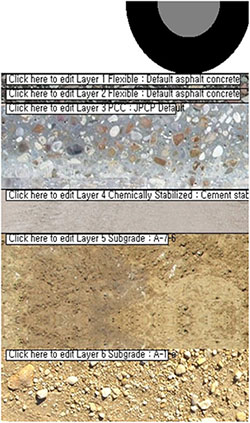 Composite pavement structure |
|
Asphalt pavement (t = 5 cm) Top |
Asphalt binder: PG 64-22, Level 1/3 Creep compliance: Level 1 (Mixtures [A]~[C]) - Input data from Fig. 3 and Table 4 Dynamic modulus: Level 3 (Aggregate gradation) | |
|
Asphalt pavement (t = 5 cm) Bottom |
Asphalt binder: PG 64-22, Level 3 Creep compliance: Level 3 (Aggregate gradation) Dynamic modulus: Level 3 (Aggregate gradation) | |
|
Concrete Pavement (t = 30 cm) |
Compressive strength = 32 MPa (Level 2) -ν = 0.21, ρ = 2,460 kgf/m3, W/C = 0.41 - LTE = 52%, Dowel = D (32 mm)/350 mm (LTE: Load Transfer Efficiency: 0-100%) - Tie bar: Installed, Widened-slab: Installed, 0.5 m - Joints are placed every 6 m Aggregate = Granite, Cement = Type 1 (Ordinary Portland Cement) | |
|
Lean Concrete (t = 15 cm) |
Elastic/resilient modulus = 13,500 MPa - ν = 0.20, ρ = 2,380 kgf/m3 | |
|
Sub grade (infinite) |
AASHTO A-7-6 AASHTO A-1-A | |
|
Distress level: limits in South Korea |
IRI = 3.0 m/km, AC Bottom-up cracking = 25% AC Rutting/thermal cracking = 13 mm/378 m/km AC Reflective cracking = 684 m/km Pavement performance evaluation for 10 years |
All the simulated results are presented in Figs. 4, 5, 6. In all simulation cases, best pavement performance was expected in Mixture [A] (i.e. mixture with limestone) as expected. Mixtures with taconite aggregate, taconite filler (i.e. Mixture [B]) and taconite aggregate, limestone filler (i.e. Mixture [C]) presented higher amount of IRI (m/km) and Reflective Cracking (RC, m/km). However, all the simulated asphalt mixtures passed required pavement performance critera (i.e. IRI = 1.6 m/km, Reflective Cracking = 684 m/km, Rutting = 13 mm) up to 8 years of pavement service life. It is assumed that taconite mixture presents similar performance compared to conventional Hot Mix Asphalt (HMA) mixture with PG 64-22 binder which is widely produced and applied in South Korea.
This means positive possibility of taconite aggregate application in actual asphalt pavement construction. However, limited research efforts: limited number of specimens, testing work and simulation works, were performed in this paper. More research activities are needed to further verify findings in this paper.
5. Summary and conclusion
In this paper, feasibility of taconite aggregate application was considered with experimental work and pavement design simulation approach. Two different asphalt mixtures: taconite with taconite filler and taconite with limestone filler, were prepared. Low temperature creep test: IDT mixture creep test, was performed and creep compliance data were achieved. Then the material testing data were input into pavement design program and synthetic performance of taconite aggregate mixture was evaluated. The positive possibility: the taconite aggregate can successfully applied in actual asphalt pavement construction, was found. However, limited research efforts were performed in this paper. More extensive research activities are needed to further verify findings in this paper. Moreover, application of several mining byproducts in South Korea as an alternative aggregate source in asphalt pavement construction needs to be considered based on the crucial findings in this study.




